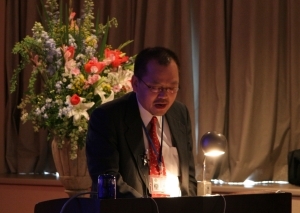Greeting from Prof. Eizo Nakamura, program leader/director

Opening remarks
Good morning and welcome to the first Misasa COE-21 International Symposium. Our goal for this program is to present research and educational activities as part of our "Center of Excellence for the 21st Century in Japan" program, or COE-21 Program. In May 2003, our institute, ISEI, was selected to be part of the COE-21 program for 5 years by the Ministry of Education, Culture, Sports, Science, and Technology of Japan, otherwise known as MEXT. As part of this program we are working to establish ISEI as an "International Research Center for Solid Earth Science". To date, this institute has been recognized as a cooperative center for Earth Science Research within Japan, and now we would like to expand it to become an international collaborative research and education center. Our focus is on advanced experimental and analytical techniques that have been developed at ISEI for understanding the origin, evolution and dynamics of the Earth. We operate advanced facilities in three basic research areas: high-pressure and -temperature materials science, geochemistry, and geochronology. The establishment of an international center here will provide excellent research opportunities for the world scientific community, especially to young researchers at the graduate and post-graduate levels, as well as to a wide range of professional geoscientists. As part of our activities as an international center, we have been inviting research scientists, post-doctoral fellows and graduate students from Japan and around the world. The number of people involved in our COE-21 Program is going up and our contributions to the scientific communities in geophysics and geochemistry are likewise expanding. One of the aims of this symposium is to showcase the progress of research supported by the COE-21 Program since mid-2003. In addition, we have many internationally-renowned keynote speakers and COE-21 international advisory committee members participating in this symposium, not only to evaluate its quality but also to provide leadership in the direction of our COE-21 program in the next three years through extensive discussions with COE-21 researchers and by reviewing papers presented in this symposium. This symposium is jointly held as a celebration on the occasion of Professor Masaru Kono's retirement to express our appreciation for his administrative services for ISEI as well as contributions to the global geodynamics community. I hope that this symposium will help develop an international collaboration center at Misasa which, in turn, will nucleate new research directions in solid earth sciences. I would like to express my thanks to all the participants, the members of the organizing committee, the COE-21 support staff, ISEI administration office, the advisory committee, MEXT, JSPS, Misasa-Town, Tottori Prefecture and Okayama University for support. Finally, I would like to dedicate this symposium to the memories of two people who during their careers were pivotal figures both at ISEI and in the solid earth science community in general, and who passed away this past year. Shun-ichi Akimoto served as a director of ISEI from 1988 to 1992, and was an established figure in the ultra-high pressure community, with great success in deep mantle mineral physics. Shen-su Sun, who died just last month, stayed here for three months in 1996, strongly influencing the early development of the geochemistry program at PML of ISEI. As you know he was one of the greatest geochemists of our generation, a walking dictionary of geochemistry. Both men will be remembered and missed. Please enjoy the meeting and your stay in Misasa. Thank you for your attention.
Speech at the symposium banquet
Ladies and Gentlemen, as Program Leader and Director of ISEI, I would like to thank all of you for attending the Misasa Symposium Banquet. Tonight is a special night, because we are also celebrating Professor Masaru Kono's retirement. My sincere thanks are extended to tonight's special guests, Lieutenant Governor of Tottori Prefecture, Mr. Shinji Hirai; Mayor of Misasa, Hidemitsu Yoshida; and Professor Kono's wife, Ms. Sumiko Kono. More than 140 people are gathered here tonight from 15 countries. This is much larger than we expected for this symposium, probably by a factor of two. I have never seen such a large number of people from so many different countries gathered together in Misasa or Kurayoshi. I believe that this is a sign that Misasa has the potential to be an international research center, where people from around the world can interact with each other through science and culture, even though Misasa is located in a rural area in the smallest prefecture dealing with population in Japan. In order to establish a world-class research center for solid earth science in Misasa, support from all of the participants from foreign countries and Japan, as well as from local autonomous bodies, is indispensable. I hope that friendships begun or strengthened at this symposium banquet will provide a means of more rapidly achieving our dream of a real World Collaborative Research and Educational Center at Misasa. Finally, I would sincerely like to thank Professor Kono for his administrative services at ISEI as director and member of the steering committee, and recognize his tremendous contributions to the global geodynamics community throughout his entire scientific career. I believe that his success is due, in no small measure, to his wife, Sumiko-san. Therefore also we would like to celebrate Professor Kono's retirement by showing our appreciation for the support offered by Ms. Kono. Please enjoy the banquet. Thank you.
Institute for Study of the Earth's Interior